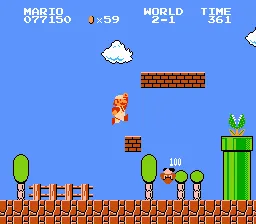
While Nintendo was taking a lot of ground with their arcade games Donkey Kong and Mario Bros. (along with their Game & Watch consoles), the game that would send the Nintendo Entertainment System to the top above all along with being a revolution on the platformer genre, is none other than the plumbers next big adventure, Super Mario Bros. For the time, Miyamoto's vision for making a fun game broke a big convention from games at the time: Instead of a gameplay loop for a high score, you had to get through distinct levels to reach a definitive end.
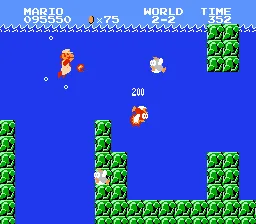
For today standards, it is still a really solid platformer, though you must be careful to not slip by accident and fall off from tight platforming if you are holding the run button. On one hand, levels are balanced in difficulty and the powerups can give you many advantages (Mushroom gives you an extra hit, Fire Flower lets you throw fireballs, and the Starman is invencibility)...but any mistakes are easily punished by the Fire Flower reverting you to small Mario (instead of just Mario as in later games), and as an early NES game, lose all your lives carelessly and you're back to the beginning.
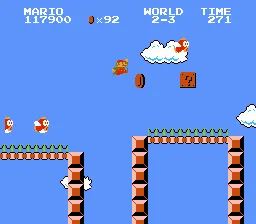
However, while the visuals are simple and worlds are abstract, the colors are appealing enough and the iconic compositions from Koji Kondo have been embedded on many people over the world, with the Overworld theme being one of, if not the most iconic Mario song ever alongside the Overworld and Athletic themes from Super Mario World. Sounds are also satisfying as you jump, stomp enemies and grab powerups with that one sound that has been brought over in almost every game in many ways.
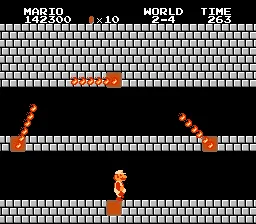
Something that it also attempted even when all levels are linear is the option of taking shortcuts (which would then evolve to more formal options like branching maps in SMB3 and World, and missions in most 3D Mario games), which was always done through an underworld level and getting near the end in the ceiling, which of course would get you to the "Warp Zone", giving you the option of one or more pipes to skip to another world.

A highly iconic game that rewards patience and precision with progress (and grabbing 100 coins with extra lives), but that also has been taken to its utmost limits thanks to the popularity of the game in speedrunning communities. A game that has become a staple in both casual gaming and the hardcore speedrunning scene for this game, and is even recognizable to those that don't play games (and of course, it would be interesting to take a look at the many ports and hacks this game received).
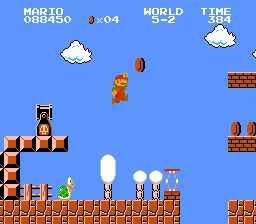
Spanish translation with DeepL. All screenshots were captured by myself.
Español

Aunque Nintendo estaba tomando mucho terreno con sus juegos arcade Donkey Kong y Mario Bros. (junto con sus consolas Game & Watch), el juego que llevaría a la Nintendo Entertainment System a lo más alto, además de suponer una revolución en el género de los juegos de plataformas, no es otro que la próxima gran aventura del fontanero, Super Mario Bros. Para la época, la visión de Miyamoto para hacer un juego divertido rompía una gran convención de los juegos de la época: En lugar de un bucle de juego para conseguir una alta puntuación, había que superar distintos niveles para llegar a un final definitivo.

Para los estándares de hoy en día, sigue siendo un juego de plataformas realmente sólido, aunque hay que tener cuidado de no resbalar por accidente y caer de las plataformas apretadas si se mantiene el botón de correr. Por un lado, los niveles están equilibrados en dificultad y los potenciadores pueden darte muchas ventajas (el Champiñón te da un golpe extra, la Flor de Fuego te permite lanzar bolas de fuego, y el Hombre Estrella es invencible)... pero cualquier error es fácilmente castigado por la Flor de Fuego que te revierte a Mario pequeño (en lugar de sólo a Mario como en los juegos posteriores), y como juego temprano de NES, pierde todas tus vidas por descuido y vuelves al principio.

Sin embargo, aunque los efectos visuales son sencillos y los mundos son abstractos, los colores son lo suficientemente atractivos y las icónicas composiciones de Koji Kondo se han incrustado en muchas personas de todo el mundo, siendo el tema del Overworld una de las canciones más icónicas de Mario, si no la más, junto con los temas del Overworld y del Athletic de Super Mario World. Los sonidos también son satisfactorios cuando saltas, pisoteas a los enemigos y coges los potenciadores con ese sonido que se ha trasladado a casi todos los juegos de muchas maneras.

Algo que también se intentaba incluso cuando todos los niveles son lineales es la opción de tomar atajos (que luego evolucionarían a opciones más formales como los mapas ramificados en SMB3 y World, y las misiones en la mayoría de los juegos de Mario en 3D), que siempre se hacía a través de un nivel del inframundo y acercándose al final en el techo, lo que por supuesto te llevaba a la "Zona Warp", dándote la opción de una o más tuberías para saltar a otro mundo.

Un juego muy icónico que premia la paciencia y la precisión con el progreso (y la obtención de 100 monedas con vidas extra), pero que también ha sido llevado a sus máximos límites gracias a la popularidad del juego en las comunidades de speedrunning. Un juego que se ha convertido en un elemento básico tanto en los juegos casuales como en la escena hardcore del speedrunning para este juego, y que es incluso reconocible para aquellos que no juegan (y por supuesto, sería interesante echar un vistazo a los muchos ports y hacks que recibió este juego).

Traducción al español hecha con DeepL. Todas las fotos capturadas por mí.